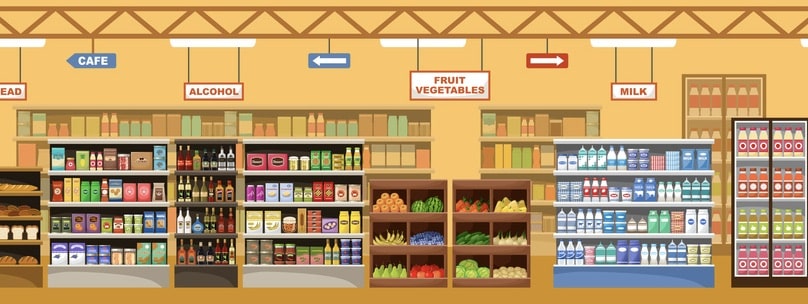While food inflation in the UK has shown signs of slowing over recent months, unfortunately, UK food prices are still up. In fact, the ONS reports that food costs have increased by over 17 percent in 12 months, and experts predict they’re unlikely to fall anytime soon.
Unsurprisingly then, the ever-increasing cost of a weekly food shop is forcing consumers to change the way they shop, as well as the way they engage with the brands they buy from.
Here are some of the changes the industry is experiencing, and what this means for food and drink brands:
1. Frozen food flourishes
As consumers look to reduce the cost of their shopping basket, many are turning their backs on fresh food, in favor of their frozen counterparts.
Data from Kantar shows that, in the 12 weeks to 20th March, demand for items such as frozen chicken rose by 5.9 percent. Meanwhile, sales of frozen prepared foods, including ready meals, pizzas and chips, increased by 2.6 percent and frozen vegetables grew by 1.3 percent.
With more shoppers forced into the category as a result of rising food costs, this obviously poses a great opportunity for frozen food brands to keep these new customers in the category for the long-run. To do this, brands now need to focus on demonstrating all the benefits that frozen food can offer—including convenience, quality, nutrition and of course, value for money.
For example, at Hatch we work with the British Growers Association on its Yes Peas! campaign, which promotes the benefits of frozen peas. But rather than simply encouraging Brits to have a portion of peas alongside their dinner, where Yes Peas! succeeds so well is by championing the vegetable to make it the star of the show, through recipe creation where peas are the hero ingredient.
Alongside this, Yes Peas! also educates consumers on the wider health and environmental benefits of the frozen pea. Not only are peas packed with nutrients (they’re frozen within 2.5 hours of being harvested to lock in all those wonderful vitamins and minerals!), but they’re also by far the most environmentally friendly vegetable in the UK; we’re 90 percent self-sufficient as a nation, and on top of that, there’s little to no waste as the pods are utilized in different ways, such as for adding organic matter and nutrients back into to the soil, or for animal feed.
Simple tactics like this can be an incredibly successful way to encourage consumption of frozen food, and recruit more consumers into the category in both the short and long-term.
2. A liking for loyalty schemes
As a result of food inflation, shoppers are inevitably looking for new ways to save money, and for many, the answer is in reward schemes. According to data from GWI, 57 percent of UK food shoppers say they use loyalty and reward schemes now—-up from 52 percent in Q3 last year.
Within reward schemes, shoppers say that a ‘special price discount’ on products is the promotion which is most likely to influence where they shop. NIQ reports that a further 44 percent of shoppers say retailer vouchers and coupons are important in determining where they shop.
Loyalty schemes can therefore be a great tactic for organizations, as it benefits both the shopper and the brand—offering savings to customers whilst encouraging sales with your brand over a competitor.
Despite this, currently, many brands are cutting the value of their reward schemes. In particular, Tesco announced in June this year that it was reducing the worth of its Clubcard vouchers from 3x their value, to now only 2x their value.
Therefore, with other loyalty schemes diminishing in value for customers, this provides an opportunity for other brands to rise up to the challenge and offer competing and enticing benefits for shoppers.
A big trend at the moment is brands offering customers reduced prices if they have a loyalty card. For example, both Tesco and Sainsburys have shaken up their loyalty scheme to introduce ‘Clubcard prices’ and ‘Nectar prices’. The initiatives offer customers with a reward card a discount on selected products, while those without a reward card have to pay the full price.
The result is that customers inevitably sign up for the free reward scheme to avoid having to pay full whack. And it works; Tesco reported after it introduced the initiative that its regular Clubcard users had increased by a whopping 2.5 million!
3. A blow for brand loyalty
Despite consumers’ love for loyalty rewards, as customers look to reduce the cost of their weekly shop, their overall loyalty to brands is waning. Shoppers are increasingly turning their back on the brands that they’ve bought from for years, in favor of cheaper alternatives.
Whether it’s opting for cheaper own-brand labels, or swapping to a brand that’s on special offer, customers are more open to switching and swapping now than before.
This doesn’t just apply to the products they buy, but where they buy them from too—data from Paragon Bank shows that one in eight (12 percent) people switched their supermarket for their main weekly shop in the first half of this year.
Even those who haven’t switched their supermarket are still swapping between brands to save some cash; more than a third (37 percent) of people who have stayed shopping with their preferred supermarket for their main shop say they are now also using cheaper stores, such as Amazon, to buy specific items.
And within all of this, only one in seven (14 percent) people who have changed their shopping habits plan to return to their previous habits when food price inflation has eased.
Therefore, for brands to keep an edge over their competitors, they need to place greater focus on keeping an engaged and loyal customer base; one that will choose their brand time and time again.
Shoppers want to know that the brands they shop with are both good for them and their pocket, as well as being good for the planet—so communicating your brand’s values is key to building an engaged audience.
But it’s not simply shouting about your brand’s eco-credentials or health benefits—people like to buy from people, which means it’s vital to also communicate the human side of your organization, so customers can feel a personal connection to your brand.
This is something that Innocent Drinks do incredibly well. The brand is renowned for its distinct tone of voice and strong values, and as a result, has seen consistent growth from £1.48bn in 2020 to £2.02bn in 2022.
It’s undeniable that inflation is having an impact on the food and drink industry. And while some of these impacts may be short-lived, some new shopping habits look to be here to stay—and brands need to respond if they’re to stay ahead of the curve. Some of Hatch’s top tips to achieve this are:
- Communicate your USPs: Whether it’s the health benefits of your products, or your sustainability credentials, make sure to communicate why consumers should buy your products over your competitors. This is often particularly important for premium brands, a brand’s USPs need to communicate the incentive to pay a higher price and trade up over a cheaper alternative. It’s also good to consider occasions within this especially amongst premium spirit brands, the idea around drinking less frequently but as a luxury or indulgence—only premium products offer this specialness that other brands can’t, so it’s important to lean into this and communicate why it’s really worth investing in a particular brand over others.
- Offer incentives: More so than ever, consumers are counting the pennies. If your brand can provide discounts or rewards, it will help you to appeal to your existing customers, attract new shoppers, and drive overall sales. There’s lots of ways you can do this which also raise brand awareness beyond just discounting products, things like teaming up with influencers to drive brand awareness and offer unique discount codes to their followers or partnering with publications to offer reader offers can all help drive sales and awareness at the same time.
- Show you’re human: Customers don’t like faceless brands; they want to buy from brands that hold the same values as themselves. Make sure you’re communicating what these values are, and showing that you care about your customers, to increase your brand loyalty. Most importantly be authentic, consumers can see straight through you, if it’s not true to your values you could see customers turning full circle and abandoning your brand.
If you’re a food or drink brand looking to stand out against your competitors and improve your sales, get in touch with Hatch at hello@hatch.group.








